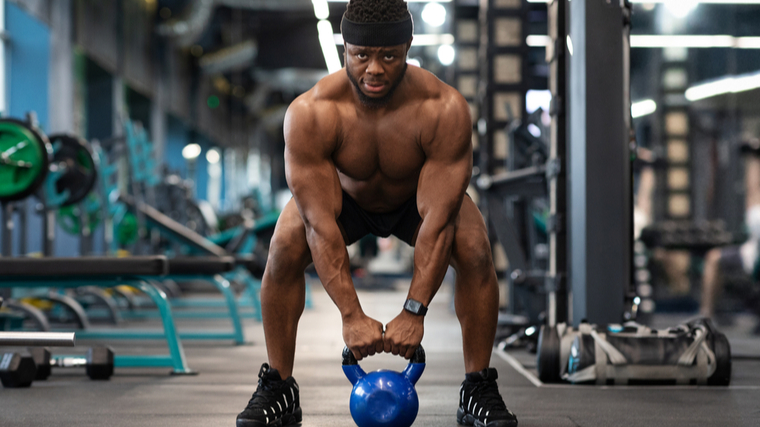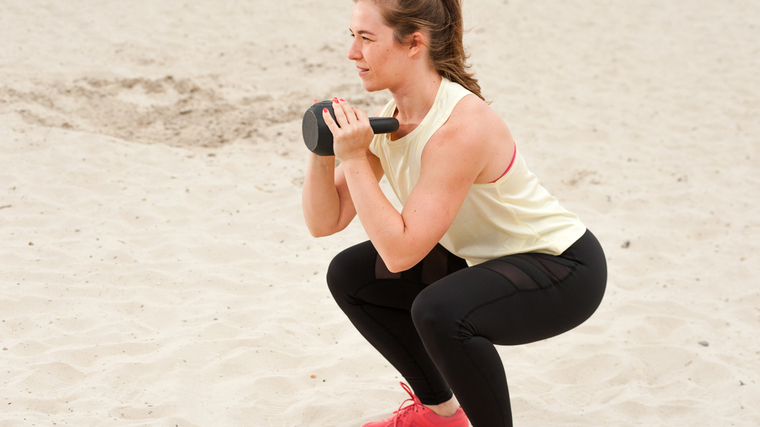You’ve only got one kettlebell, and you need an actual workout program. Don’t worry — contrary to what it might feel like; you’ve already got all the equipment you need. Figuring out how to design a single kettlebell training program isn’t too daunting, as long as you let yourself sit down and figure out what your goals are.
With just a single kettlebell, you might be afraid of limiting yourself. But creating any training program for yourself is generally about combining where you’re at with where you want to be. And that’s something you can do with a single kettlebell. If the bell is too heavy for certain upper body lifts, you can supplement your program with bodyweight work and two-handed single kettlebell lifts. On the other hand, if it’s a light bell and you want to do heavier lower body exercises, you can weave kettlebell training strategies into your program to maximize your lower body gains.

Whatever your goals are, you can chase them effectively with just one kettlebell. This article will take you through designing your single kettlebell training program. You’ll also learn about the benefits of training with just one kettlebell, as well as how to warm up most effectively during your kettlebell program.
What is a Single Kettlebell Training Program?
On the surface, designing a single kettlebell training program is just that — creating a program based on just one kettlebell. That’s quite true. But the reality is also a lot more nuanced than that.
A program based around just one kettlebell is likely to feature a lot of conditioning work, by nature of most kettlebell moves. They are often full-body-oriented and explosive, making for getting strong and more cardiovascularly fit. Knowing this key feature of a one-kettlebell program can help you wrap your head around the perhaps unusual experience of single-implement training. This doesn’t mean that one kettlebell won’t make you strong, though.
Kettlebells are shaped so oddly that they provide more off-balance weight distribution than a dumbbell. That leads to more recruitment of your stabilizer muscles, which helps improve your grip and core strength tremendously. In other words, a program designed around just one kettlebell can be highly effective on multiple fronts.

And remember that your kettlebell is not the only training tool in your box. You can (and should) include bodyweight moves into your training, as well. Especially if you have a light bell, bodyweight work can help pre-exhaust your muscles so that a light bell will feel a lot heavier during your lifts.
Depending on your goals, your kettlebell program might also incorporate tempo training, 1 ½ reps, and EMOM (every minute on the minute) or AMRAP (as many reps as possible) workouts. Kettlebell flows are also a potent way to spice up your single kettlebell program. Keeping these options at the top of your mind while designing your program can help you maximize results.
Benefits of Training with a Single Kettlebell
You might be designing a program around just one weight because you don’t have access to other gym equipment. Or, it’s time to simplify your training by going back to the fundamentals. Whatever your reasons, when a program centers around a single implement, it’s crucial to think about what that implement can do for you that is unique.
Fight Strength and Muscle Asymmetries
Working out with just one kettlebell generally forces unilateral movement, where you’re only using one side of your body at a time. Yes, you can do moves while grasping one bell with both hands — this can be invaluable when training your upper body with a heavy kettlebell. But in general, you’ll be performing movements first on one side, then the other — or alternating every rep.
Alternating reps — say, while performing cleans or swings — can help increase core involvement because you’ll have to continually stabilize against rotation while performing the switch. Your core will still be very engaged to keep you balanced when you’re performing all your right reps in one go, then all your left reps.
By keeping your body balanced while lifting separately with both sides of your body, you’ll be making yourself stronger overall. But you’ll also be making your body more resilient against potential injuries by reducing strength and muscle asymmetries that can develop when you only work with barbells. Because your less dominant side will be forced to perform the same number of reps as your more dominant side, your strength and muscular development will start to even out. This is excellent news for strength athletes who need to maintain consistent bar paths — think, powerlifters — and develop symmetrical muscles, like bodybuilders.
Space and Money Saver
This one kind of speaks for itself. If you’re only training with one kettlebell, you have all the equipment you need right on your yoga mat. Even if you’re performing a relatively space-intensive move like the Turkish get-up, you only really need a space of your body length plus a couple of feet on either side of you. And if that’s too much space to ask for, kettlebell windmills and simple overhead reverse lunges take up even less space — while providing similar benefits.
Further, once you’ve invested in the one kettlebell to rule them all, you don’t have to buy other equipment for a program like this. You might want to grab an exercise mat to work on or even add resistance bands to your warm-up or supplemental bodyweight exercises. But at its core, any program built around a kettlebell is a relatively cheap and highly effective way to train.
Low-Impact Cardio and Strength
If you’re only using a single kettlebell for all your workout needs, the odds are that it’s a lot lighter than you could use for lower body lifts. That’s because if you’re only using one weight to perform both overhead presses and goblet squats, the limiting factor of weight selection will likely be your overhead presses. That doesn’t mean you can’t still get a fantastic lower body workout with a light kettlebell — but it does mean that the loads will generally be lighter than they would be using more equipment. Because of this, your joints will likely take less of a beating.
View this post on Instagram
[Read More: The Best Bodyweight Exercises, + Workouts and Tips From a CPT]
This is also true for the cardio and conditioning components of kettlebell training. Unlike running — which requires you to hit the ground with your feet repetitively — your feet stay on the ground even during the most ballistic kettlebell moves. That means that you can get all the conditioning benefits with so much of a lower impact on your joints.
How to Create a Program with a Single Kettlebell
Designing your workout program is exciting because it’s all about you. You get to consider your likes, dislikes, and experience levels in ways that cookie-cutter programs can’t. Here’s how to get started with developing your program to train with just one kettlebell.
Assess Your Starting Point
Before you start designing an at-home training program, you’ve got to know what you’re training for. To understand what you’re training for, you need to figure out where you’re currently at fitness-wise.
If you’re relatively new to kettlebell training, you’ll want to make sure you have a mastery of the basic moves — think swings, presses, and cleans. You can even build up to Turkish get-ups and kettlebell snatches. But whatever moves you plan on integrating, make sure you have them down solid. Just like you wouldn’t program heavy barbell overhead squats, if you can’t perform them with good form, make sure you know which kettlebell moves you can safely start with.
You’ll also want to be realistic with yourself about your conditioning. It’s one thing to know how to perform a kettlebell swing, but quite another to be able to swing a lot — which you might want to do in your program. Where’s your conditioning level at? Because kettlebell work can be cardio-intensive, try swinging your kettlebell with excellent form for 30 seconds, then a minute. Can you do it? If not, maybe that becomes a goal in your program. If yes, you know more about your starting baseline.
Determine Your Goals
Sometimes you’re training to increase strength, hypertrophy, conditioning, or to change your body composition. Other times, you want to refine a particular move. The elusive kettlebell snatch might be something you want to take the time to master with your program. Increasing your overhead strength, mobility, and overall conditioning would become the goals of your program because you need all of those for a good kettlebell snatch.
Creating exercise-based goals like this can help you accomplish your larger, more general goals. Since you’re only working with one implement and therefore can’t move up in terms of the weight you’re lifting, you’ll need to goal-set other benchmarks for yourself.

For example, do you want to improve your conditioning (which includes getting stronger and better at cardio moves)? Note that, and then note the way you want to measure it. You won’t be testing a 1RM or sprint speed, but you can do an AMRAP benchmark workout to see how your body has adapted. You might set a goal of performing x number of reps in y amount of time or being able to perform a certain amount of unbroken kettlebell swings. Either way, creating specific ways of measuring your goals makes your progress as measurable as possible.
Select a Training Split
Choosing an exercise frequency and training split for your program go hand-in-hand due to the recovery needs that each workout places on your body. If each workout you perform heavily involves the full-body — which is very likely with kettlebell conditioning — you may have to train less frequently to accommodate recovery needs.
That said, there are still ways to divide up your kettlebell sessions. And while you might want to choose a traditional, muscle group-focused training split, it may be most effective to treat kettlebells as the unique implements that they are. It can help perform full-body splits, divided further by strength and conditioning emphases, described below.
Or, you may want to split your training into upper and lower days. Remember that moves like the kettlebell snatch heavily recruit from the lower body. In the same way, lower body moves like the kettlebell goblet squat require a lot of upper body recruitment. So plan accordingly.
Choose a Training Frequency
Once again, your goals come into play while choosing your workout frequency. Are you mainly focused on conditioning? Consider how many times per week your body can adequately recover from intensive conditioning sessions.
[Read More: The Most Effective Workout Splits, Created by Our Experts]
If you’re a newcomer to conditioning and/or kettlebell training, your program may consist of two or three workouts a week. If you’re more experienced, you might have three or four conditioning sessions a week. Then, ask yourself if you want to add any strength or hypertrophy days into your training. Just make sure whatever you add fits into a sustainable program that includes recovery days.
Complete this process in reverse order if your main goals are strength or hypertrophy. First, determine how many strength-focused days fit into your program, then add conditioning-focused days as needed. Remember that the nature of kettlebell training means that workouts focused on conditioning will get you stronger, and strength kettlebell workouts will likely improve your conditioning.
Design Your Workouts
When designing your workouts, it’s important to emphasize movement balance. Consider where the weak points in your programs tend to be — do you often forget to include lateral or rotational movements in your training, for example? It can help to keep in mind the seven fundamental movement patterns: horizontal push, horizontal pull, vertical push, vertical pull, knee-dominant moves, hip-dominant moves, and rotational moves.
Do your workouts contain representative exercises from each of these groups? Making sure they’re dispersed throughout your single kettlebell program will help you ensure balance and even the development of your strength, muscles, and functional fitness levels. Fortunately, since you’re only working with one bell, your program will, by nature, feature unilateral movements that will work wonders for your functional fitness and symmetrical development as an athlete.
Another thing to consider when designing your workouts is integrating what you don’t like into your program. All things being equal, the exercises you hate are often where you need the most improvement. When you’re working with such a simple, bare-bones program, it’s the perfect time to target your weaknesses. Your strengths can get even stronger if you do, and you’ll accomplish your goals much faster.
How to Warm Up During Your Single Kettlebell Program
Ideal warm-ups will cater to the specific workout you’re about to perform. Are you going to be performing a lot of snatches or other overhead work? Pay special attention to your shoulders, lats, and traps during your warm-up.
In general, though, there are some key ways to activate your entire body that will make you generally ready to take on the kettlebell program you’ve designed for yourself. The following is a sample warm-up for a single kettlebell training program that you can incorporate as you see fit.
- Cat-Cow: 2 x 30 seconds
- Inchworm to Hip Opener: 3 x 8 per side
- Kettlebell Deep Squat: 3 x 10
- Reverse Snow Angel: 3 x 15
- Kettlebell Lateral Lunge: 3 x 8 per side
- Kettlebell Windmill: 3 x 8 per side
More Than Just Swinging
Get creative about what kinds of moves you put into your program. Sure, you only have one kettlebell, but that doesn’t mean you only have one move. Designing a single kettlebell program can help you reach all kinds of training goals — all you have to do is get to work.
Featured Image: Prostock-studio / Shutterstock